LET THERE BE LIGHT
below: kaleidoscopic image of Ambrose Bierce
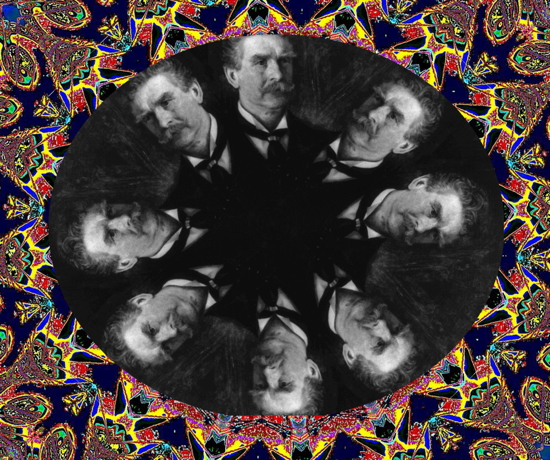 Kaleidoscopes: Never Plug Them In Kaleidoscopes: Never Plug Them In
|
by Don Swaim
_______________________________
While this essay isn’t about books or Ambrose Bierce as such, it is about art—and in art there is Truth with a capital T. To Bierce, Truth is “An ingenious compound of desirability and appearance.”
The same may be said of the kaleidoscope, which is the epitome of the analog experience, sooo Victorian, yet à la mode. Ingenious, desirable, superannuated, and seductive as hell.
It’s fair to say nearly everyone loves peering into a kaleidoscope’s eyepiece. A well-made scope tenders an infinite panorama of colors, shapes, and ceaseless designs sweeping the solo viewer from the unremarkable into a better galaxy composed of brilliance and depth. Just add music! The often breathtaking psychedelic effect is produced, not by drugs, but by the unassuming fusion of glass and mirrors.
Mystical without the mysticism.
In the simplest sense, a kaleidoscope is merely a cylinder containing mirrors that, within, reflect any number of colored objects, such as bits of glass or beads. When turned or jiggled, a limitless quantity of polychromatic shapes burst before the unsuspecting, yet willing, eye.
Kaleidoscopes can be mesmerizing, a word Bierce defines as, “Hypnotism before it wore good clothes, kept a carriage, and asked Incredulity to dinner.”
A Scot named David Brewster invented the kaleidoscope in 1815, and got around to patenting it two years later. Initially, Birmingham, England, lens manufacturer Philip Carpenter was the sole maker of Brewster’s kaleidoscopes, but a flaw in the patent application allowed others to copy, unfettered, poor Brewster’s design.
Today, as a toy, kaleidoscopes can be cheaply mass produced. However, when hand-crafted by artisans, they’re often dazzling (sometimes ignored) works of art, as beautiful on the outside as they are inside.
What is now called a mirror was, in Bierce’s day, referred to as a looking-glass, which Bierce defines as “A vitreous [glass in appearance or physical properties] plane upon which to display a fleeting show for man’s disillusion.” Cynical Bierce might have thought otherwise had he gazed into the engaging, mirrored kaleidocope, assuming he had not.
All the scopes pictured here are from my inventory.
I bought my first hand-crafted kaleidoscope (below) from a middle-aged, hearing-impaired couple at an outdoor craft fair in Washington Square, New York City. While their speech was nearly unintelligible, the deaf couple was visibly delighted as I gushed over their intricate designs. They could see and build what they could not hear.
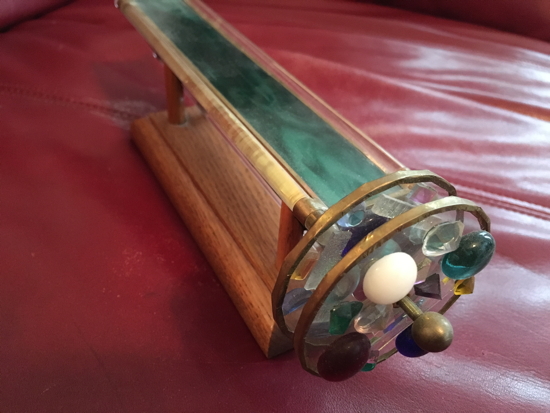
Subsequently, I occasionally acquired hand-crafted kaleidoscopes at craft fairs or at the few arts shops vending the objects, such as Artisans Gallery in Lahaska, PA.
Inspired, I naively decided to build my own kaleidoscopes, and bought a “simple” how-to book.
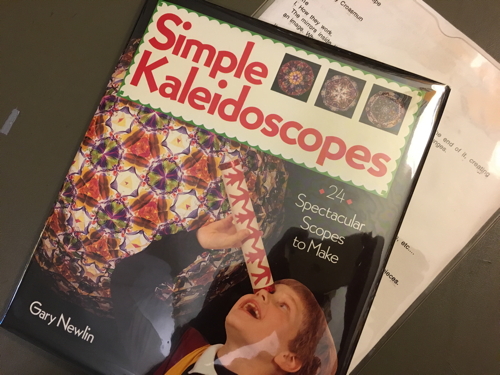
While the book appeared to be aimed at children, the specifics were more daunting than I had imagined. Therefore, I reasoned, the best way to begin was to buy an actual kaleidoscope kit (I wound up acquiring three such kits), which arrived with parts and instructions. Earlier, I had successfully constructed a rather large Tiffany-style hanging lamp from a kit, so how much harder could building a kaleidoscope be?
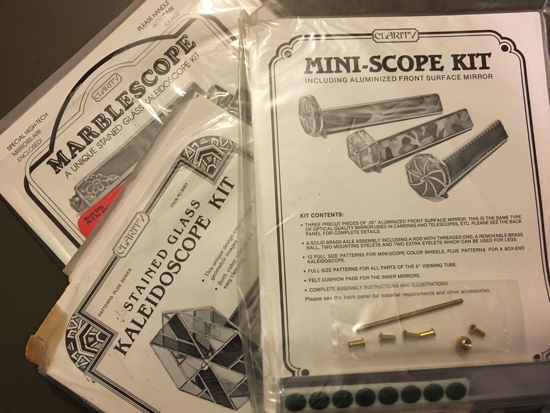
The kits had to be supplemented with my own tools:
protective goggles
rubber gloves
soldering gun & solder
soldering stand
scythestone
brushes
pliers
copper foil
clamps
etc., etc.
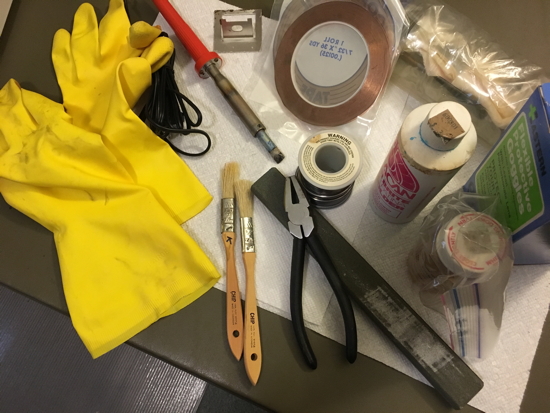
After acquiring many irregular pieces of glass and plastic (below) obtained from the trash cans of Manhattan retail glass stores, which had plenty of glass leavings they ordinarily threw out, I was all set, or so I thought.
 It’s an understatement to say that I was an abject failure. Rubber gloves and goggles not withstanding, none of my scopes turned out right, most falling apart even before they were finished. Simple plumbing a toilet was easier, although without the art. Out of my league, I was faced with either more dedication to the craft, training, or resigning myself to the ability of others more talented. Alas, the latter prevailed, even though I hung on to the various artifacts of the pursuit in case I changed my mind.
It’s an understatement to say that I was an abject failure. Rubber gloves and goggles not withstanding, none of my scopes turned out right, most falling apart even before they were finished. Simple plumbing a toilet was easier, although without the art. Out of my league, I was faced with either more dedication to the craft, training, or resigning myself to the ability of others more talented. Alas, the latter prevailed, even though I hung on to the various artifacts of the pursuit in case I changed my mind.
Several of my favorite kaleidoscopes were handmade by Bob and Elissa Rioux of Kennebunkport, Maine, whose studio, The Sea Parrot, creates some of the most gorgeous scopes on the continent.
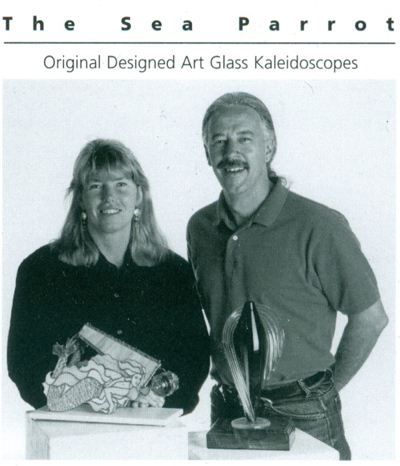
Once, a wheel broke and fell off a kaleidoscope (below) I had bought from Bob at a craft fair in Fort Washington, PA. At the fair the following year, where he again exhibited, I brought the broken kaleidoscope to him, and he gladly repaired it and also mailed me an extra laser wheel “for your troubles.” The wheels are easily removed by turning the big, brass screw in front.
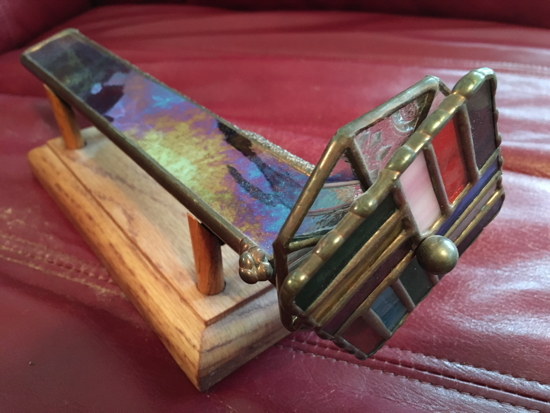
A recent kaleidoscope (below) was crafted by Pete Berule of Hamilton, Montana, who builds lower-priced scopes from wood.
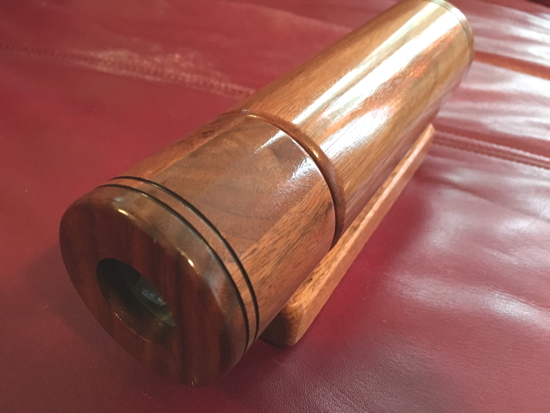
One inexpensive, tiny, plastic scope was sent to me by an Ambrose Bierce Site admirer, and while the scope itself has negligible value it fits perfectly into a striking cut-glass vessel, which makes the difference.
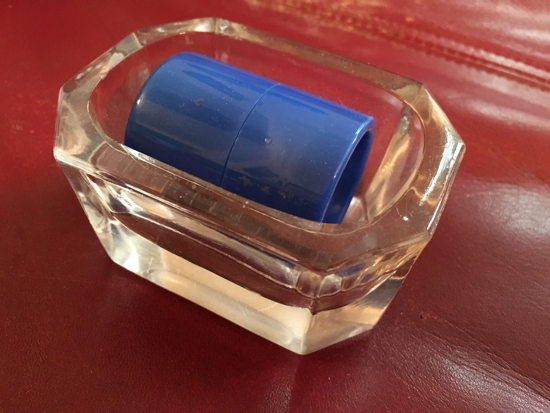
Another scope uses colorful marbles that can be inserted interchangeably:
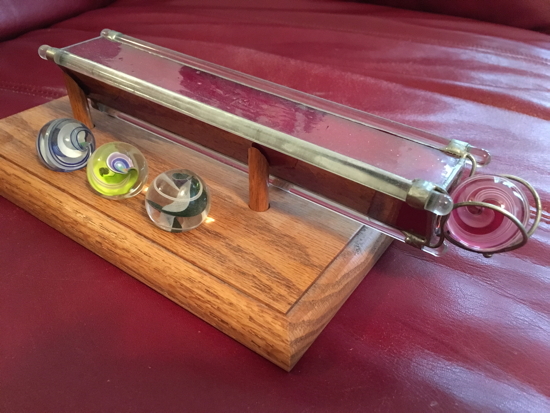
A stunning, shiny scope made of brass and glass:

The scope below, made by David Sugich of Santa Barbara, California, uses shifting objects in a cross tube. Fun, but needs a stand.
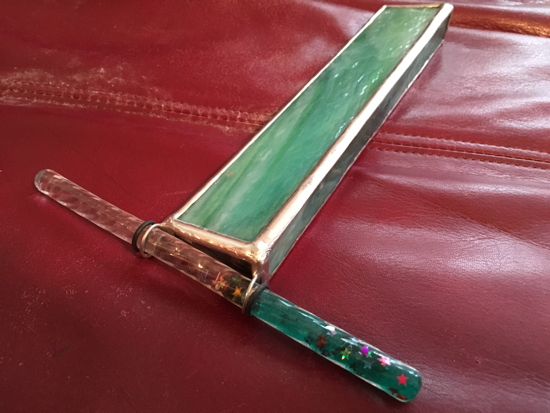
The following [Sea Parrot] scopes are among the most complex and ambitious (and expensive):
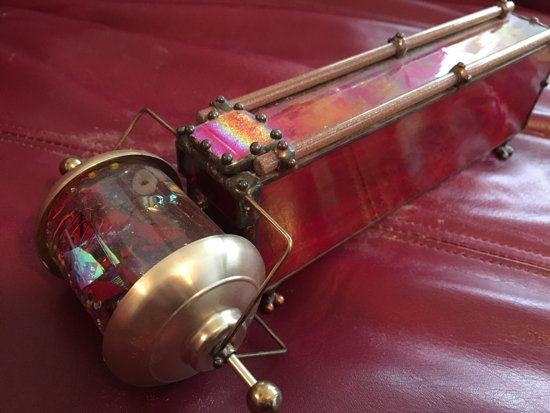
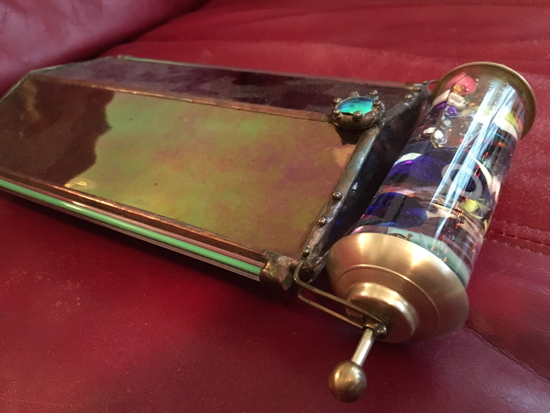
The scope below was created by Joanne Jacobs of Fantasy and Glass Works in Hempstead, Long Island, in August 2000. She calls it the "Zenith." Jacobs, who has a degree in Classical Performance at Queens College, began her career as a performer. But on her way home from a gig one night she saw a stained glass lamp in a shop window and was hooked, and began selling her scopes at craft fairs.
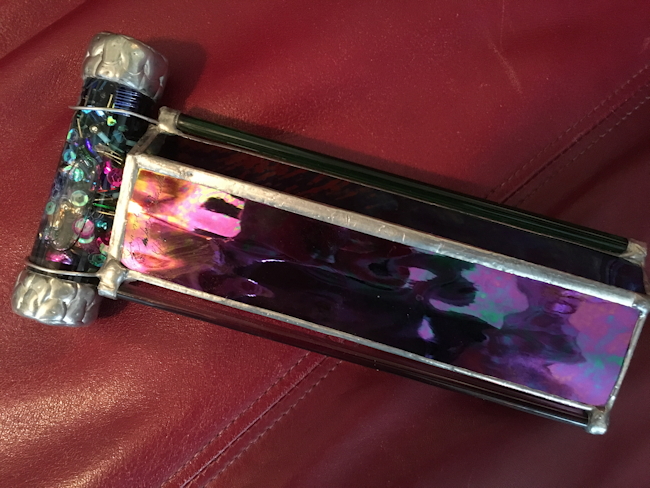 Acruing crafted kaleidoscopes isn’t the cheapest diversion—but it beats owning a boat, horse, vintage cars, or vacation chalet. Or perhaps not if one has issues in paying the rent—although that’s a plight the artisans of these wondrous devices also share. Esthetically, however, the results can be sublime, with or without alcoholic enhancement, and each scope’s visual landscape is limitless. Plus scopes need nothing more than a decent eye, a little light, and a shelf or two on which to display them.
Acruing crafted kaleidoscopes isn’t the cheapest diversion—but it beats owning a boat, horse, vintage cars, or vacation chalet. Or perhaps not if one has issues in paying the rent—although that’s a plight the artisans of these wondrous devices also share. Esthetically, however, the results can be sublime, with or without alcoholic enhancement, and each scope’s visual landscape is limitless. Plus scopes need nothing more than a decent eye, a little light, and a shelf or two on which to display them.
Ambrose Bierce knew the “Book of Genesis” was nonsense, but were he alive he would surely assert, should he speak Latin, Lux sit.
|
|















